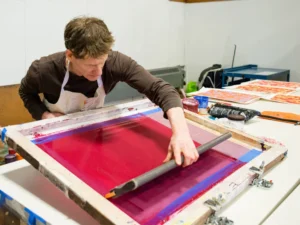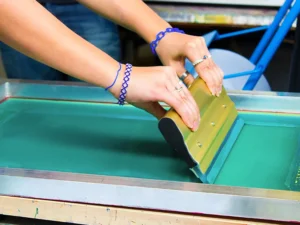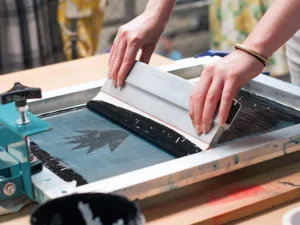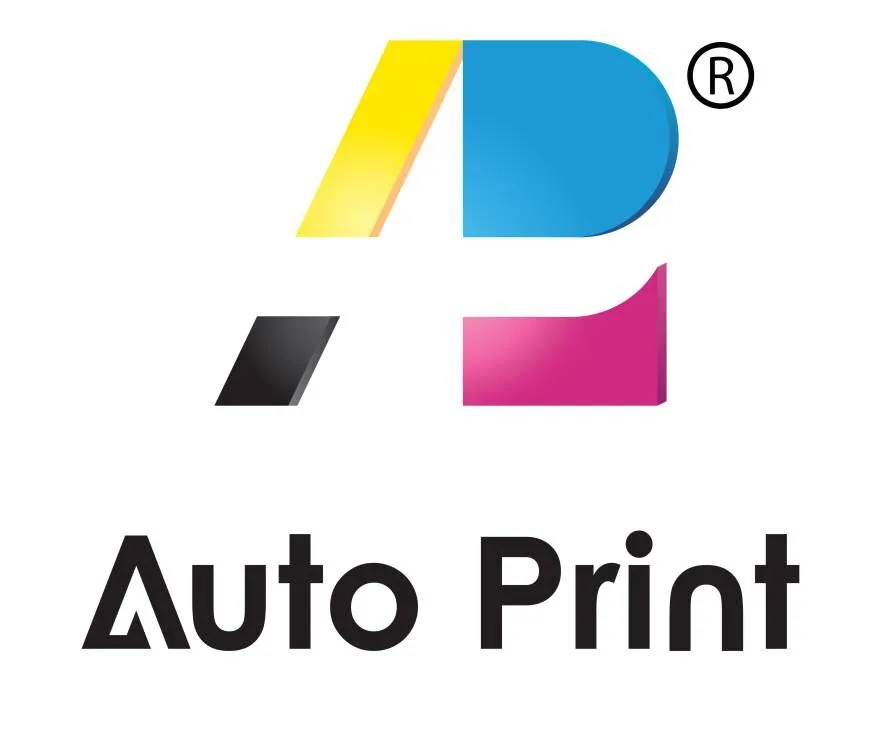가장 일반적이고 오랜 시간 검증된 인쇄 절차 중 하나는 '스크린 인쇄'입니다. 어두운 직물에도 생생한 색상을 생성할 수 있어 직물과 종이에 인쇄하는 데 가장 많이 사용되는 기술입니다.
스크린 인쇄란 무엇인가요?
스크린 인쇄는 메쉬 스크린에 인쇄하는 과정으로 정의할 수 있습니다. 스크린 인쇄는 세리그래피 또는 실크스크린 인쇄라고도 합니다.
스텐실 메쉬 스크린을 통해 강제로 잉크를 사용하여 패턴을 인쇄합니다. 스크린 프린터는 메쉬 스크린, 잉크, 스퀴지를 사용하여 스텐실 패턴을 평평한 표면으로 옮깁니다.
특수 잉크를 사용하면 천이나 종이가 아닌 목재, 금속, 플라스틱, 유리 등 다양한 표면에 스크린 인쇄를 적용할 수 있습니다. 스크린 인쇄 디자인은 단일 색상의 잉크를 사용하거나 다양한 색상을 사용할 수 있습니다. 다양한 색상의 물체로 작업하는 경우 각 잉크에 대해 별도의 스텐실을 사용하여 한 번에 하나씩 색상을 적용합니다.
6가지 스크린 인쇄 프로세스 유형
인쇄 요구 사항에 따라 스크린 인쇄 프로세스에 대한 몇 가지 옵션이 있습니다:

별색 스크린 인쇄
별색 스크린 인쇄 프로세스는 다양한 색상 분리에서 파생된 별색을 스크린 인쇄에 활용합니다. 별색은 스크린 프린터를 사용하여 스크린에 단색 및 모양으로 인쇄할 수 있습니다.
별색 스크린 인쇄 프로세스
이것이 스크린 인쇄의 첫 번째 유형입니다. 먼저 아트웍을 다듬고 인쇄할 준비가 되었는지 확인하세요. 효과적으로 인쇄하려면 디자인과 단어 또는 숫자 등이 최신 상태이고 색상과 적절히 분리되어 있는지 확인해야 합니다.
색상이 잘 분리되어 뚜렷하지 않거나 아트웍의 해상도가 너무 낮으면 제품의 최종 인쇄물이 원하는 만큼 멋지지 않습니다.
따라서 고품질 출력물을 제작하려면 선명한 색상 분리와 뛰어난 해상도를 찾는 것이 중요합니다.
둘째, 스텐실과 같은 도구를 사용하여 디자인을 제품에 옮깁니다. 스텐실을 사용하면 제품(의류)에 잉크가 잘 흡수되어 선명하고 풍부한 색상을 얻을 수 있습니다. 위는 별색 스크린 인쇄 프로세스입니다.
별색 스크린 인쇄의 이점
- 별색 스크린 인쇄는 가장 인기 있는 스크린 인쇄 방법 중 하나입니다. 다양한 직물과 의류에 생생한 원색으로 인쇄할 수 있습니다.
- 색상을 완벽하게 제어하여 선명하고 깨끗하며 정돈된 결과물을 만들 수 있습니다.
- 다른 스크린 인쇄 기법처럼 색상이 혼합되지 않기 때문에 사용하기가 더 쉽습니다.
- 이 방법은 티셔츠, 스웨트셔츠 및 재킷을 인쇄하는 데 탁월한 선택입니다.
하프톤 인쇄
하프톤 인쇄로 알려진 스크린 인쇄 기술은 음영과 작은 점을 강조합니다. 특히 한 가지 색상만 포함된 단색 인쇄물은 이 방식으로 인쇄할 수 있습니다.
하프톤 인쇄는 인쇄된 잉크 색상 중 하나가 배경보다 더 진하고 두드러질 때 가장 멋지게 보입니다. 한 가지 색의 잉크만 사용한 다음 하프톤으로 처리하기 때문에 멀리서 보면 잉크가 다른 색조로 보입니다.
반면에 이 작품은 전체 디자인이 단 하나의 색조로 구성되어 있음을 명확하게 보여줍니다. 색상을 단색이 아닌 점의 정밀한 패턴으로 인쇄하면 멀리서 볼 때 수많은 색조나 음영의 '환영'을 볼 수 있습니다.
하프톤 스크린 인쇄 프로세스
스크린 프린터가 먼저 디자인을 생성합니다. 그림에 결함이 있는 경우 이 절차를 사용하면 스크린 인쇄 도트가 적절한 보기에 충분히 정확하지 않습니다.
다시 말해, 화질이 좋지 않은 사진은 최종 인쇄물에서 좋지 않게 보일 수 있습니다. 따라서 가장 뛰어난 효과를 얻으려면 이미지의 해상도가 충분히 높은지 확인하세요.
또한 메시 수가 많은 화면이 필요합니다. 이 절차에서 중요한 단계는 잉크 도트를 올바르게 배치하는 것입니다. 너무 강한 힘으로 잉크 도트를 누르지 않는 것이 가장 좋으며, 그렇지 않으면 제대로 인쇄되지 않습니다. 위는 하프톤 스크린 인쇄 프로세스입니다.
하프톤 인쇄의 이점
한 종류의 잉크만 필요하기 때문에 저렴합니다.
이 스크린 인쇄 방법은 한 가지 색조만 사용하여 "겉으로 보기에" 다양한 음영을 생성하기 때문에 다른 방법과 다릅니다.
단색 아트웍이나 음영 아트웍을 만들 때 권장됩니다.
그래픽 아티스트와 디자이너는 단색 잉크로 이루어진 미세한 점을 사용하여 다양한 색상을 표현함으로써 상상력을 실험하고 적용할 수 있습니다.

그레이 스케일 인쇄
그레이 스케일 인쇄물을 만들려면 0에서 255 사이의 그레이 스케일 값을 사용해야 합니다. 스크린 인쇄에서는 흰색 빛의 양을 늘리거나 반사하거나 검은색 빛의 반사량을 줄이거나 흡수(반사 대신)하여 색상을 캡처합니다.
그레이스케일 스크린 인쇄 프로세스
이름과는 달리 흑백 방식이 아닙니다. 그레이 스케일은 흑백처럼 실제 흑백을 사용하여 사진을 특성화하지 않습니다. 대신 RGB 또는 CMY 색 구성표를 사용하지만 다양한 회색 음영을 사용합니다.
디자인이나 이미지의 품질이 높고 RGB 또는 CMY를 사용하여 적절한 색상 표현이 가능한지 확인한 후 사진을 흑백에서 회색조로 변환할 수 있습니다.
이 스크린 인쇄 방법은 회색 음영을 구분할 수 있는 밝기 수준의 픽셀을 기반으로 합니다. 픽셀은 측정된 밝기가 있기 때문에 그 음영을 나타낼 수 있습니다.
다른 말로 표현하면 회색 톤은 밝기 범위의 중간인 (흰색) 사이에 해당한다고 할 수 있습니다. 사진이 회색조로 변환된 후에는 각 픽셀의 밝기에 따라 이미지의 모든 음영을 이 범위에 배치할 수 있습니다. 위는 그레이스케일 스크린 인쇄 프로세스입니다.
그레이스케일 인쇄의 이점
- 밝은 회색과 어두운 회색의 이미지를 저렴한 비용으로 사용할 수 있습니다.
- 고품질 인쇄 결과
CMYK 인쇄
CMYK 인쇄에는 시안, 마젠타, 노란색, 키(또는 검정)의 네 가지 기본 색상만 있습니다. 이 기술은 여러 가지 색상으로 인쇄할 수 있는 저렴한 스크린 인쇄 기술을 찾고 있는 경우에 적합할 수 있습니다.
CMYK 스크린 인쇄 프로세스
이 과정에서는 네 가지 색상을 검은색 키 플레이트와 결합하는 것이 중요합니다. 키 플레이트는 다양한 색조와 대비를 통해 그림을 구성할 수 있게 해줍니다. 따라서 이 단계는 더 나은 디테일을 추가하고 적절한 이미지 보기를 보장하는 데 필수적입니다. 위는 CMYK 인쇄 프로세스입니다.
CMYK 인쇄의 이점
- 밝은 색상이나 흰색 의류에 더 적합합니다.
- 인화 품질은 4가지 이상의 색상을 사용한 사진과 동등한 수준입니다.
- 스크린 인쇄의 주문 및 디자인 프로세스를 간소화하세요.
스크린 인쇄 프로세스 시뮬레이션
시뮬레이션 프로세스를 사용한 인쇄는 일반적인 스크린 인쇄 기술입니다. 디자인에서 컬러 하프톤을 사용할 수 있으므로 사진 인쇄에 이상적입니다.
스크린 인쇄 프로세스 시뮬레이션
이 스크린 인쇄 절차는 원본 아트웍의 색상을 캡처하기 위해 하프톤 잉크 색상을 사용하는 것을 강조합니다. "심 프로세스"라고도 하는 이 기법은 소재의 밝은 색과 어두운 색 모두에 이점을 제공합니다.
디자인과 이미지는 독립적으로 유지될 수 있습니다. 이 과정은 종종 학생들이 색채 이론을 익히는 여정에 도움이 됩니다. 그림은 필요에 따라 복잡하거나 기본적인 것일 수 있습니다.
하프톤과 그라데이션이 결합된 별색 등 다양한 색상 기법이 시각적 효과를 높여줍니다. 따라서 의류에 재미있는 그래픽이나 패턴을 넣을 수 있는 공간이 더 넓어집니다. 위는 스크린 인쇄 프로세스 시뮬레이션입니다.
스크린 인쇄 시뮬레이션 혜택
- 최종 인쇄된 사진은 생생하고 생생하며 세심한 디테일이 살아 있습니다.
- 어두운 색조와 밝은 색조 모두에 유용하기 때문에 널리 사용되고 있습니다.
듀오톤 인쇄
듀오톤 인쇄는 두 가지 하프톤의 조합을 사용하여 동일한 그림을 두 가지 색상으로 제작하는 스크린 인쇄 기법입니다.
즉, 하나의 하프톤은 검정 잉크로 인쇄되고 다른 하프톤은 따뜻한 갈색 등의 컬러 잉크로 인쇄됩니다.
듀오톤 스크린 인쇄 프로세스
따뜻한 갈색 하프톤의 색조를 사용하여 듀오톤 인쇄를 하려면 따뜻한 갈색 하프톤과 검은색 하프톤을 사용합니다. 외관상 세피아 톤 이미지와 비슷합니다. 위는 듀오톤 스크린 인쇄 프로세스입니다.
듀오톤 인쇄의 이점
- 가벼운 섬유 및 의류에 적합
- 완성된 인쇄물에 세련되고 예술적인 외관을 부여합니다.

스크린 인쇄 사업을 시작하고 싶으신가요?
스크린 인쇄는 독특한 아트웍을 제작하는 전통적인 방법으로, 여러 세대에 걸쳐 대규모 주문에 널리 사용되어 왔습니다.
회사에 가장 적합한 스크린 인쇄 프로세스를 선택하려면 먼저 다양한 스크린 인쇄 양식을 모두 학습하고 비교한 후 특정 요구 사항을 분석해야 합니다. 스크린 인쇄 프로세스마다 각기 다른 이점이 있습니다. 자신에게 가장 적합한 스크린 인쇄 프로세스를 선택해야 합니다.
그 외에도 적절한 색상 관리 소프트웨어를 사용하면 고객이 선택할 수 있는 다양한 색상에 대한 가격 선택을 제어할 수 있습니다. Once Tech는 다양한 유형의 스크린 인쇄 기계와 필요한 도구를 선택하는 데 도움을 드릴 수 있습니다.
스크린 인쇄기 하면 ONCE TECH만 떠올릴 수 있습니다. 수동 및 자동 원통형 실크 스크린 인쇄기와 현대적이고 사용하기 쉬운 멀티 컬러 자동 원형 실크 스크린 기계를 포함한 완벽한 원형 인쇄 장비 라인을 제공합니다.
다양한 인쇄 절차에 대해 알아보고 인쇄 회사에 수익성을 확보하세요. 위의 절차를 분석하여 비즈니스에 가장 적합한 절차를 선택하세요.

